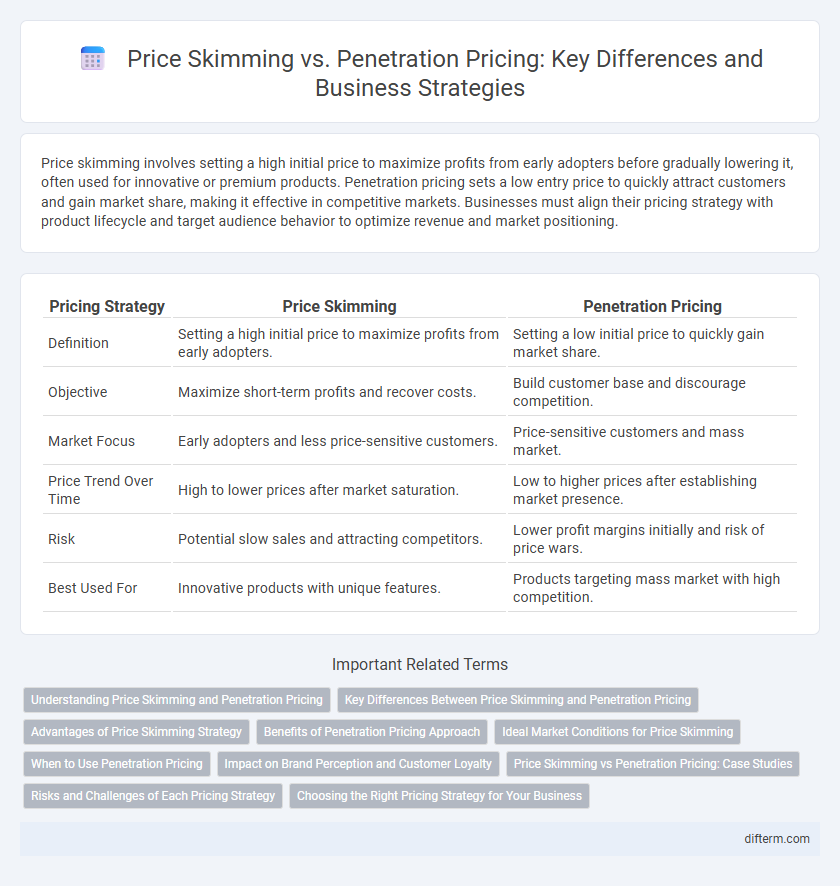Price skimming involves setting a high initial price to maximize profits from early adopters before gradually lowering it, often used for innovative or premium products. Penetration pricing sets a low entry price to quickly attract customers and gain market share, making it effective in competitive markets. Businesses must align their pricing strategy with product lifecycle and target audience behavior to optimize revenue and market positioning.
Table of Comparison
| Pricing Strategy | Price Skimming | Penetration Pricing |
|---|---|---|
| Definition | Setting a high initial price to maximize profits from early adopters. | Setting a low initial price to quickly gain market share. |
| Objective | Maximize short-term profits and recover costs. | Build customer base and discourage competition. |
| Market Focus | Early adopters and less price-sensitive customers. | Price-sensitive customers and mass market. |
| Price Trend Over Time | High to lower prices after market saturation. | Low to higher prices after establishing market presence. |
| Risk | Potential slow sales and attracting competitors. | Lower profit margins initially and risk of price wars. |
| Best Used For | Innovative products with unique features. | Products targeting mass market with high competition. |
Understanding Price Skimming and Penetration Pricing
Price skimming involves setting a high initial price for a new product to maximize profits from early adopters before gradually lowering the price. Penetration pricing sets a low initial price to quickly gain market share and attract a broad customer base. Both strategies require careful analysis of market demand, competition, and cost structure to optimize revenue and growth.
Key Differences Between Price Skimming and Penetration Pricing
Price skimming involves setting a high initial price to maximize profits from early adopters before gradually lowering it, while penetration pricing starts with a low price to quickly attract customers and gain market share. Skimming targets consumers willing to pay a premium, whereas penetration pricing aims for mass market adoption and competitive barrier creation. The choice between these strategies depends on market demand elasticity, competition intensity, and product lifecycle stage.
Advantages of Price Skimming Strategy
Price skimming maximizes early profits by targeting consumers willing to pay a premium, enabling rapid recovery of research and development costs. This strategy helps establish a high-quality brand perception and generates substantial revenue before competitors enter the market. It also allows businesses to adjust prices strategically as market demand evolves, maintaining profitability over product lifecycle stages.
Benefits of Penetration Pricing Approach
Penetration pricing offers rapid market entry by setting low initial prices to attract a large customer base and increase market share quickly. This strategy discourages competitors from entering the market due to reduced profit margins, fostering brand loyalty and long-term customer retention. Businesses benefit from economies of scale as higher sales volumes reduce per-unit costs, enhancing overall profitability.
Ideal Market Conditions for Price Skimming
Price skimming is most effective in markets with high consumer willingness to pay, limited competition, and strong brand loyalty, allowing businesses to maximize profits from early adopters. This strategy suits innovative products or technologies with unique features and inelastic demand where customers value exclusivity and are less price-sensitive. Ideal conditions also include rapid product lifecycle depreciation, enabling price reductions over time to capture more price-sensitive segments later.
When to Use Penetration Pricing
Penetration pricing is most effective when entering highly competitive markets where rapid customer acquisition and market share growth are critical. Businesses launch products at low prices to attract price-sensitive customers and discourage competitors from entering the market. This strategy works well for products with elastic demand and economies of scale that support long-term profitability after initial low-margin sales.
Impact on Brand Perception and Customer Loyalty
Price skimming often positions a brand as premium, creating an impression of exclusivity that can enhance customer loyalty among early adopters willing to pay a higher price. Penetration pricing, by offering lower initial prices, aims to rapidly build market share but risks being perceived as lower quality, which may challenge long-term brand loyalty. The choice between these strategies significantly influences brand perception and customer retention, with skimming fostering prestige and penetration emphasizing accessibility.
Price Skimming vs Penetration Pricing: Case Studies
Price skimming proves effective in tech industries where companies like Apple launch innovative products at premium prices, capturing high margins before competitors enter. Penetration pricing is demonstrated by Netflix's market entry strategy, offering low subscription costs to rapidly acquire large user bases and deter competition. Case studies highlight that price skimming suits markets with less price sensitivity and strong brand loyalty, whereas penetration pricing thrives in price-sensitive, competitive markets to drive volume growth.
Risks and Challenges of Each Pricing Strategy
Price skimming poses the risk of alienating cost-sensitive customers and attracting competitors to quickly enter the market with lower-priced alternatives. Penetration pricing challenges include sustaining low profit margins initially and the difficulty of raising prices without losing customer loyalty once the market is established. Both strategies require careful market analysis to avoid long-term financial drawbacks and brand perception issues.
Choosing the Right Pricing Strategy for Your Business
Selecting the optimal pricing strategy hinges on your business goals and market conditions, where price skimming targets early adopters with higher initial prices to maximize profits quickly, while penetration pricing aims to capture market share rapidly through low prices. Understanding customer segments and competitive landscape guides whether to prioritize short-term gains or long-term growth. Analyzing cost structures, demand elasticity, and brand positioning ensures alignment with your overall business strategy for sustained success.
Price Skimming vs Penetration Pricing Infographic

 difterm.com
difterm.com